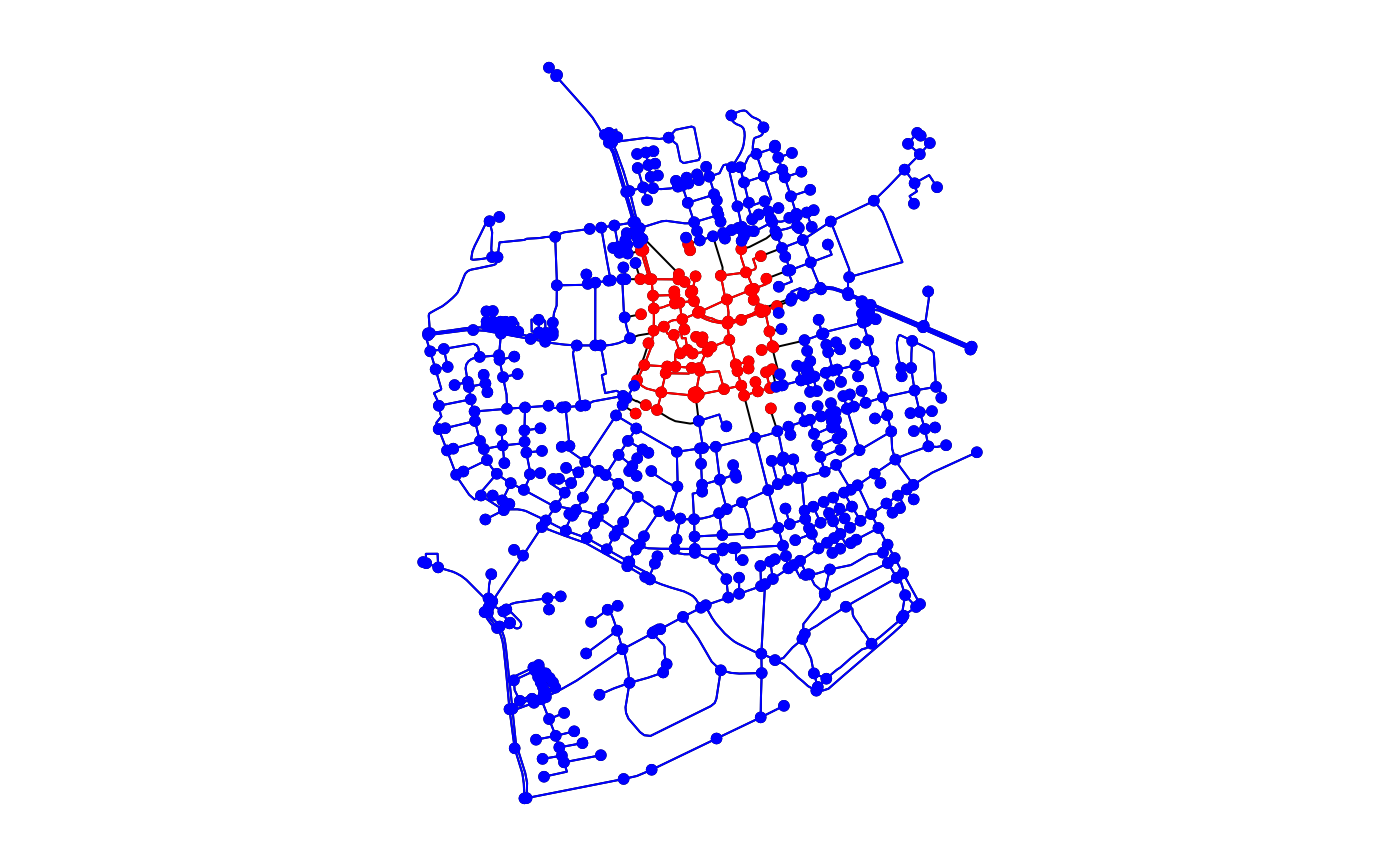These functions allow to interpret spatial relations between nodes and
other geospatial features directly inside filter
and mutate calls. All functions return a logical
vector of the same length as the number of nodes in the network. Element i
in that vector is TRUE whenever any(predicate(x[i], y[j])) is
TRUE. Hence, in the case of using node_intersects, element i
in the returned vector is TRUE when node i intersects with any of
the features given in y.
node_intersects(y, ...)
node_is_disjoint(y, ...)
node_touches(y, ...)
node_is_within(y, ...)
node_equals(y, ...)
node_is_covered_by(y, ...)
node_is_within_distance(y, ...)Arguments
- y
The geospatial features to test the nodes against, either as an object of class
sforsfc.- ...
Arguments passed on to the corresponding spatial predicate function of sf. See
geos_binary_pred.
Value
A logical vector of the same length as the number of nodes in the network.
Details
See geos_binary_pred for details on each spatial
predicate. Just as with all query functions in tidygraph, these functions
are meant to be called inside tidygraph verbs such as
mutate or filter, where
the network that is currently being worked on is known and thus not needed
as an argument to the function. If you want to use an algorithm outside of
the tidygraph framework you can use with_graph to
set the context temporarily while the algorithm is being evaluated.
Note
Note that node_is_within_distance is a wrapper around the
st_is_within_distance predicate from sf. Hence, it is based on
'as-the-crow-flies' distance, and not on distances over the network. For
distances over the network, use node_distance_to
with edge lengths as weights argument.
Examples
library(sf, quietly = TRUE)
library(tidygraph, quietly = TRUE)
# Create a network.
net = as_sfnetwork(roxel) %>%
st_transform(3035)
# Create a geometry to test against.
p1 = st_point(c(4151358, 3208045))
p2 = st_point(c(4151340, 3207520))
p3 = st_point(c(4151756, 3207506))
p4 = st_point(c(4151774, 3208031))
poly = st_multipoint(c(p1, p2, p3, p4)) %>%
st_cast('POLYGON') %>%
st_sfc(crs = 3035)
# Use predicate query function in a filter call.
within = net %>%
activate("nodes") %>%
filter(node_is_within(poly))
disjoint = net %>%
activate("nodes") %>%
filter(node_is_disjoint(poly))
oldpar = par(no.readonly = TRUE)
par(mar = c(1,1,1,1))
plot(net)
plot(within, col = "red", add = TRUE)
plot(disjoint, col = "blue", add = TRUE)
 par(oldpar)
# Use predicate query function in a mutate call.
net %>%
activate("nodes") %>%
mutate(within = node_is_within(poly)) %>%
select(within)
#> # A sfnetwork with 701 nodes and 851 edges
#> #
#> # CRS: EPSG:3035
#> #
#> # A directed multigraph with 14 components with spatially explicit edges
#> #
#> # Node data: 701 × 2 (active)
#> within geometry
#> <lgl> <POINT [m]>
#> 1 TRUE (4151491 3207923)
#> 2 TRUE (4151474 3207946)
#> 3 TRUE (4151398 3207777)
#> 4 TRUE (4151370 3207673)
#> 5 TRUE (4151408 3207539)
#> 6 TRUE (4151421 3207592)
#> # ℹ 695 more rows
#> #
#> # Edge data: 851 × 5
#> from to name type geometry
#> <int> <int> <chr> <fct> <LINESTRING [m]>
#> 1 1 2 Havixbecker Strasse residential (4151491 3207923, 4151474 32079…
#> 2 3 4 Pienersallee secondary (4151398 3207777, 4151390 32077…
#> 3 5 6 Schulte-Bernd-Strasse residential (4151408 3207539, 4151417 32075…
#> # ℹ 848 more rows
par(oldpar)
# Use predicate query function in a mutate call.
net %>%
activate("nodes") %>%
mutate(within = node_is_within(poly)) %>%
select(within)
#> # A sfnetwork with 701 nodes and 851 edges
#> #
#> # CRS: EPSG:3035
#> #
#> # A directed multigraph with 14 components with spatially explicit edges
#> #
#> # Node data: 701 × 2 (active)
#> within geometry
#> <lgl> <POINT [m]>
#> 1 TRUE (4151491 3207923)
#> 2 TRUE (4151474 3207946)
#> 3 TRUE (4151398 3207777)
#> 4 TRUE (4151370 3207673)
#> 5 TRUE (4151408 3207539)
#> 6 TRUE (4151421 3207592)
#> # ℹ 695 more rows
#> #
#> # Edge data: 851 × 5
#> from to name type geometry
#> <int> <int> <chr> <fct> <LINESTRING [m]>
#> 1 1 2 Havixbecker Strasse residential (4151491 3207923, 4151474 32079…
#> 2 3 4 Pienersallee secondary (4151398 3207777, 4151390 32077…
#> 3 5 6 Schulte-Bernd-Strasse residential (4151408 3207539, 4151417 32075…
#> # ℹ 848 more rows